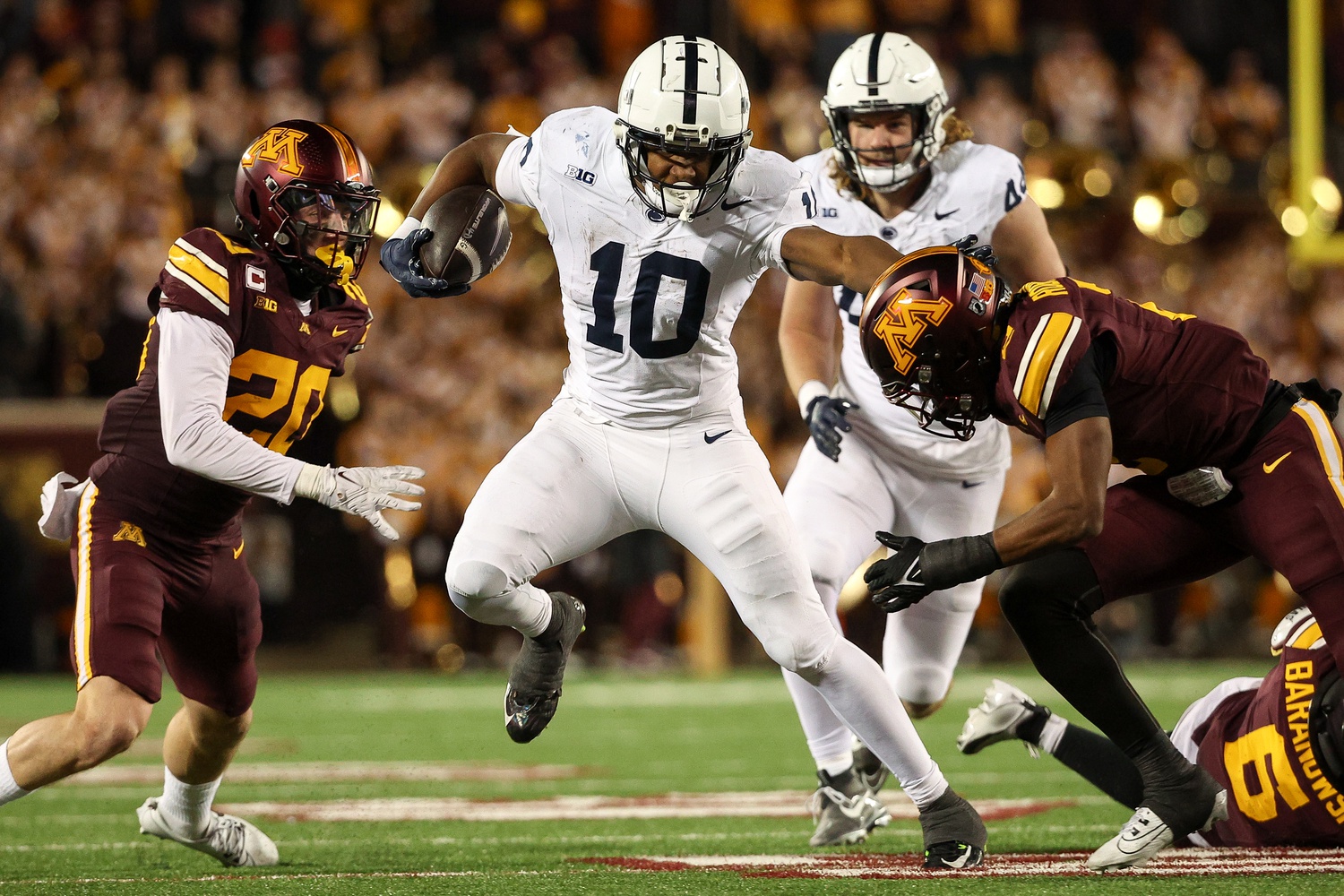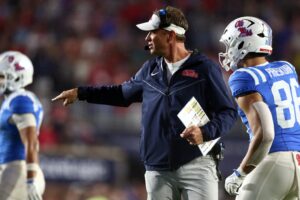After a game that was a lot closer than it should have been, Penn State survives against Minnesota and can see a path to the Big Ten title. Penn State defeated Minnesota on the road, winning the Victory Bell Trophy, by a score of 26-25. After the most complete team win of the season last week against Purdue, this game was a nail-biter. Penn State moves to 10-1 (7-1 in the Big Ten) on the season and has a potential path to the Big Ten title game. Head coach James Franklin and special teams coordinator Justin Lustig effectively won the game with an aggressive play call, and Penn State’s largest star shone brightly in the Minneapolis evening.
Not surprisingly, the fate of Penn State’s Big Ten results is closely linked to the Ohio State Buckeyes. With Ohio State’s 38-15 win over Indiana, there are three teams tied for second place in the conference behind undefeated Oregon. Ohio State, Indiana, and Penn State all sit at 7-1 in the conference. Nittany Lions fans now potentially cheer for Michigan to beat Ohio State next week. Why potentially? If Michigan wins that game and Penn State defeats Maryland, they’ll play for the Big Ten title. However, it is debatable if a potential matchup with Oregon to earn a first-round College Football Playoff (CFP) bye as Big Ten champ is better than having the week of the Big Ten title game off. In that scenario, Penn State would likely host a first-round CFP game.
Key Takeaways: Penn State Survives with Path to Big Ten Title
In their 26-25 win over Minnesota, Penn State kept their CFP hopes alive. Additionally, with Ohio State’s win over Indiana, there is a path to the Big Ten title game. However, it is debatable if that is the better alternative for Penn State, compared to not facing Oregon in the Big Ten title game, and resting for a CFP first-round home game.
Where’s Warren?
Whenever quarterbacks Drew Allar or Beau Pribula drop back to pass, their first thought is likely, “Where’s (Tyler) Warren?” Quite frankly, it is fitting that it would be their first thought as he is a quarterback’s prototypical security blanket. Warren was a star in this game, as he has been for many contests this season. He further cemented his resume for postseason awards such as the Mackey Award, and should even garner some consideration for the Heisman. In this matchup, he had a crucial catch on fourth down with less than a minute left in the game. That conversion ended the game and preserved the Penn State victory. Warren finished the game with eight receptions for 102 yards.
It was also a historically significant game for Warren. He set the record for the most yards from scrimmage for a Big Ten tight end in a season. Additionally, Warren became Penn State’s all-time leader in receiving yards by a tight end. His conversion on fourth down to seal the victory was a fitting end for the leader of Penn State’s offense this season. In Inspector Gadget-like fashion, Warren not only lined up at tight end. Similar to other games this season, he also took direct snaps and ran out of the Wildcat formation. In this contest, he also had a punt to his credit.
Putting the Special in Special Teams
Of the three phases of football, Special Teams is the easiest to overlook. In fact, it is mostly talked about when there are material errors that impact the outcome of a game. That was almost the situation for Penn State in this game. However, a gutsy call by Franklin and Lustig totally redeemed the special teams corps and propelled the team to the win.
In the first half, it appeared that Special Teams could, and potentially would, cost Penn State the game. In the first half, the calamities started with a partially blocked punt by Minnesota. The Golden Gophers then converted the ensuing drive, scoring a touchdown. Later, toward the end of the first half, Penn State was within an extra point of tying the game after scoring a touchdown. However, Minnesota blocked the extra point and returned it to the endzone for two points to take a 19-16 lead into halftime.
A fateful play call in the fourth quarter redeemed the Special Teams. On a fourth-and-one from the Penn State 34-yard line, Penn State sent out the punt team. In a move that would help clinch the win, with Riley Thompson in punt formation, Luke Reynolds received the snap and ran for 32 yards. From there, it became a matter of running out the clock to preserve the win.
By the Numbers: Penn State Survives with a Path to the Big Ten Title
Offense
Passing: Penn State threw for 244 yards, compared to 175 for Minnesota. Allar completed 21 of 28 for 244 yards, with one touchdown and no interceptions. For Minnesota, Max Brosmer completed 15 of 23 for 175 yards, with one touchdown and one interception. His interception followed a streak of five games without throwing one.
Rushing: Penn State had 117 yards, compared to 106 yards for Minnesota. Nick Singleton led Penn State, and all players, with 63 rushing yards on 13 carries, and a touchdown. Courtesy of his carry on the fake punt play, Reynolds finished with 32 yards on the one carry. Allar had the other Penn State rushing touchdown. Minnesota was led by Darius Taylor, who had 58 yards on 27 carries. Marcus Major rushed 10 times, gaining 37 yards and a touchdown.
Receiving: Warren led Penn State with a game-high 102 yards on eight catches. Omari Evans had a receiving touchdown, as part of his 51-yard game over two catches. For Minnesota, Daniel Jackson led the team with six receptions for 90 yards. Jameson Geers had one catch for 21 yards, which was Minnesota’s only receiving touchdown.
Defense/Special Teams
Defense: Jaylen Reed led Penn State defenders with 10 tackles. Kobe King had nine tackles, while Tony Rojas contributed six tackles and the only sack for Penn State. Penn State’s two turnovers were courtesy of Dom DeLuca (interception) and Zakee Wheatley (fumble recovery). Cody Lindenberg led Minnesota with a game-high 14 tackles, while Koi Perich added 13.
Special Teams: For Penn State, Ryan Barker converted both field goal attempts, including a season-long 45-yarder. He also converted two out of three of his extra-point attempts, with the miss mentioned above (which resulted in two points for Minnesota). Thompson punted two times, averaging 39.5 yards per punt. Warren was credited with a 16-yard punt. For Minnesota, Dragan Kesich converted all three of his field goal attempts, as well as both extra point attempts. Mark Crawford punted three times, averaging 40.3 yards per punt.







